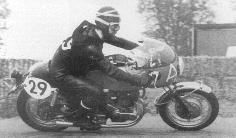 |
|
HISTORY |
|
 |
The MOTO LAVERDA Company was created in 1949 by Francesco LAVERDA who decided to diversify the production from its essentially agricultural roots. The consequences of the Second World War had ruined Italy and people was looking for a means of transport that would be cheap to buy and to drive. The LAVERDA factory obviously directed its research towards this new demand and from 1949 to 1969 built small motorbikes of 75 to 200ccs, which had remarkable racing results in Italy. |
Nevertheless, the 1960s were less fruitful as the Italians progressively went from two to four wheels for their usual means of transport, the motorbikes being perceived more as a leisure or sports vehicle. |
|
It was notably thanks to Francesco's son, Massimo, that the LAVERDA Company was able to meet these new circumstances and renewed its success, proposing a large displacement parallel twin (650cc) in 1968. (A prototype had been displayed at the London Show in 1966.) The real revolution that this bike brought to the motorcycle world has never been sufficiently emphasized. Breaking radically with the transalpine methods of the time, its conception was inspired by some famous foreign productions, in particular the Honda CB 77s. Moreover, the factory didn't hesitate to use quality foreign equipment (Bosch electrical fittings, Smiths speedos and rev counters, then Nippon-Denso, etc.) when the usual items supplied by some Italian accessory providers were not to the same level of quality. Finally, the factory was endowed with a string of highly qualified craftsmen and a top quality casting which led to superior quality frames and engines. LAVERDA's aim was therefore quite clear - to offer the biggest-engined motorbike in the world, without exceeding the weight or the dimensions of the motorbike of reference at the time: the 750 Honda Four. |
|
This photo had been taken in 1952: One can already see whose who built, 16 years later, the 750 and 1000 projects: Francesco Laverda (at right), his son Massimo (squatting ) and the ingeneer Luciano Zen (with cigarette at left). Photo Piero Laverda.
|
|